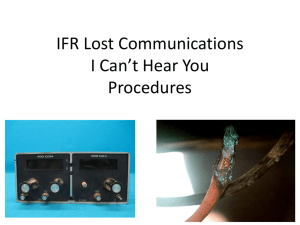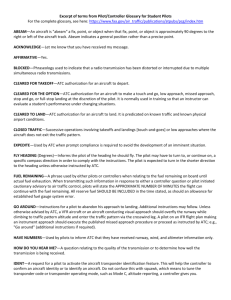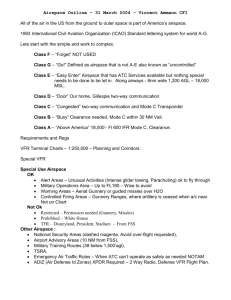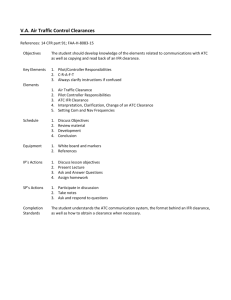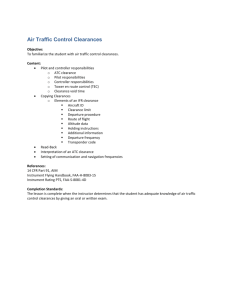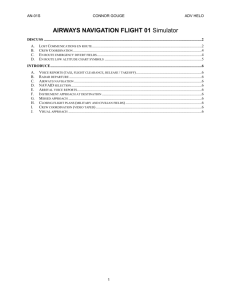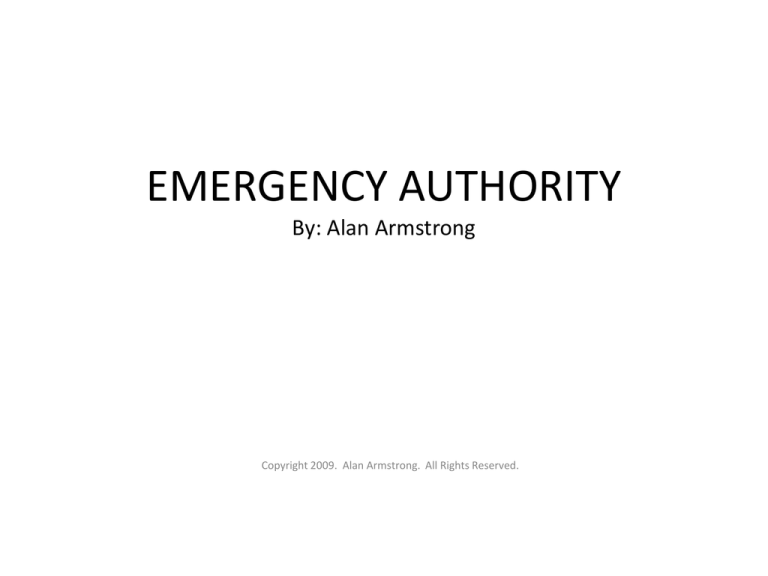
EMERGENCY AUTHORITY
By: Alan Armstrong
Copyright 2009. Alan Armstrong. All Rights Reserved.
I.
BACKGROUND
•
The PIC is the final authority to the safe outcome of the flight FAR Section 91.3(a).
•
There are a number of regulations and provisions in the AIM that confirm the nature and extent of
the PIC’s emergency authority.
•
There are several misconceptions about the emergency authority of a pilot.
•
The first is if you declare an emergency you will be buried in paperwork. While there are several
FAR that declare a report may be requested, in my experience being buried in paperwork seldom
follows an exercise of emergency authority, provided you did not create the emergency by poor
judgment or improper pre-flight planning.
•
Second, It is important that you are not meeting an emergency you created.
•
Third, you may be deviating to meet an emergency even though the “E” word is never stated or
declared
Page 2
II.
THE REGULATIONS AND
AERONATUICAL INFORMATION MANUAL
•
91.3(a)
Pilot-in-Command is the final authority with respect to
operation of the aircraft.
•
91.3(b)
The Pilot-In-Command may deviate as required to meet an
in flight emergency to the extent required to meet the
emergency.
•
91.3(c)
The FAA may require the pilot to submit a written report.
- - This is seldom required in my experience.
•
91.123(b)
“Except in an emergency no person may operate contrary to an
ATC instruction…”
NOTE: Section 91.123 (b) says you will not deviate from an
“instruction.”
Page 3
•
An instruction is not a defined term in FAR § 1.1 – The Definitions -- Nor is it
a defined term in the Pilot/Controller Glossary of AIM.
•
“Air Traffic Control clearance. An authorization by Air Traffic Control for the
purpose of preventing a collision between known aircraft, for an aircraft to
proceed under specified conditions within controlled airspace. The Pilot-InCommand of an aircraft may not deviate from the provisions of a VFR or IFR
clearance except in an emergency or unless an amended clearance has been
obtained.” AIM, Pilot/Controller Glossary, p. 937.
•
91.123(c)
•
NOTE: This regulation does not equate a clearance with an instruction, but
an instruction remains an undefined term. Note also that I have seen the
FAA include a violation of Section 91.123(c) for a momentary altitude
deviation.
“Each Pilot-In-Command who, in an emergency, or in response
to a traffic alert and collision avoidance system resolution
advisory, deviates from an ATC clearance or instruction shall
notify ATC of that deviation as soon as possible.”
Page 4
•
91.123(d)
•
AIM 6-3-1(d)
“Distress communications have absolute priority over other
communications, and the word MAYDAY commands radio
silence on the frequency…”
•
AIM 6-3-1(c)
“While MAYDAY is repeated three times to signal the aircraft
is in distress, PAN-PAN is repeated three times to convey to
ATC an urgent condition.
“Each Pilot-In-Command who (though not deviating from a rule
under this subpart) is given priority by ATC in an emergency
shall submit a detailed report of that emergency within 48
hours to the manager of that ATC facility if requested by ATC.
Page 5
• AIM 6-3-2(a)
“A pilot in any distress or urgency condition should
immediately take the following action, not necessary in the
order listed, to obtain assistance:
1. Climb, if possible for improved communications, and
better radar and direction finding detection. However, it
must be understood that unauthorized climb or descent
under IFR conditions within controlled airspace is
prohibited, except as permitted by 14 C.F.R. § 91.3(b).”
•
NOTE:
What the FAA is saying is just because you are too low to talk
to ATC or be seen on radar is not, alone, a reason to climb
into IFR conditions. Nor, are you authorized to descend into
IFR conditions. However, you may take action to meet the
emergency under § 91.3(b) and this may include climbing or
descending into IFR conditions. After all, you are the Pilot-InCommand under § 91.3(a).
Page 6
•
AIM 6-3-2(a)(2):
If you have declared an emergency or conveyed an urgent
condition to ATC, you remain on your discrete code if IFR or
continue squawking 1200 if VFR. You only squawk 7700 if
you cannot communicate with ATC.
•
AIM 6-3-2(a)(3):
Your distress or urgency call should include:
a.
b.
c.
d.
e.
f.
g.
h.
i.
j.
k.
MAYDAY or PAN-PAN;
Name of station addressed;
Aircraft identification and type;
Distress or urgency;
Weather;
Pilot’s intentions and request;
Present position and heading; or if lost, last known
position, time and heading since that position;
Altitude;
Fuel remaining in minutes;
Number of people on board;
Other useful information.
Page 7
•
AIM 6-3-2(b):
•
Reading these provisions together explains the old adage:
“After establishing radio contact, comply with advice and
instructions received…”
“Climb, Communicate, Confess and Comply.”
•
AIM 6-3-2(c) :
Bailout or Crash Landing. Time and circumstances
permitting broadcast:
- (1)
ELT Status
- (2)
Visible landmarks
- (3)
Aircraft color
- (4)
Souls on board
- (5)
Emergency equipment on board
Page 8
•
•
AIM 6-3-2(c):
-
Ditch near surface vessel
-
Remain with your aircraft
Review of Transponder Codes:
7500 Hijack
7600 Nordo
7700 Emergency
Page 9
III.
PRE-FLIGHT PLANNING
•
Remember you should not create the emergency.
•
So that means proper pre-flight planning.
Page 10
•
91.103 (a):
IFR: Wx, forecasts, fuel requirements, alternate, traffic delays
Any flight: runway lengths, take off and landing distance in
AFM or other reliable data on aircraft performance.
•
AIM 5-1-1:
Preflight Preparation: Wx, departure and arrival airports,
en route, navaid status, NOTAMS both Local and Distant
•
AIM 5-1-1(f): Info to provide briefer:
(1) Type of flight plan IFR/VFR
(2) Aircraft N number and pilot’s name
(3) Aircraft type
(4) Departure airport
(5) Route of flight
(6) Destination
(7) Flight altitudes
(8) ETD and ETE
Page 11
•
91.167(a):
IFR Fuel Requirements
a. Fly to first airport, missed approach
b. Fly to alternate, missed approach
c. Fly 45 minutes at normal cruising speed.
NOTE: Normal cruising speed may be a bone of
contention.
•
91.185
Radio Failure on IFR Flight Plan
(b) VFR land as soon as practicable
(c) IFR: Route Cleared, direct, expect, filed,
Altitude: Higher for the route segment of cleared,
minimum en route altitude (mea), or altitude told
to expect.
Page 12
WAKE TURBULENCE
•
AIM 7-3-8(c): Pilots are reminded that in operations conducted behind
all aircraft, acceptance of instructions from Air Traffic Control in the
following situations is an acknowledgement that the pilot will ensure
safe takeoff and landing intervals.
•
VFR Fuel Requirements
•
FAR 91.151:
Note:
•
30 minute day and 45 minute night
FAA Interpretation 2005-12 says using reserve fuel is not alone a
violation of the FAR .
91.119
Minimum safe altitudes
-
500’ above other than congested areas
-
No closer than 500’ to person, vessel or structure
-
Congested area 1000’ above highest obstacle within
2,000’ horizontal radius of aircraft
-
This comes into play if you are scud running
Page 13
IV.
AN EMERGENCY MAY BE UNDECLARED
•
Airliner departing Hawaii for Germany.
•
Returned without dumping fuel and landed overgross.
•
Emergency was never declared.
•
However, Captain was deviating from FARS to meet an emergency
and exonerated.
Page 14
V.
HOW TO DEFEND YOURSELF
Two magic words:
#1
“Unable:” I can’t comply with your clearance or
instruction.
#2
“Block Altitude” if in turbulence.
Page 15
VI.
CONCLUSION
•
The better your pre-flight planning and the better you
understand the requirements of the FAR, the less likely you
will be required to exercise your emergency authority
because of something you did or failed to do.
•
If you do confront an emergency, deviate from the
regulations and deal with the impact of the deviation later.
•
Don’t hesitate to declare an emergency.
•
Don’t forget “Unable.”
•
Don’t forget “Block Altitude.”
Page 16
•
Don’t forget that if you are cleared to depart after a jet less than
3 minutes after it departed, you can decline the takeoff
clearance.
•
When ATC says “caution, wake turbulence” it is putting the
responsibility for separation on your shoulders.
•
You can decline the clearance.
•
So, the better your pre-flight planning, the less likely you will
have to employ your emergency authority and the more
defendable your position if you do declare an emergency.
•
If you do have to employ your emergency authority, having a
complete knowledge of the regulations and procedures should
make you less apprehensive in exercising your emergency
authority.
Page 17

